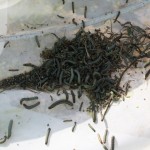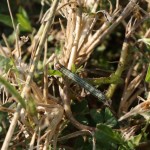I am re-running the article below ….. there are many reports of heavy infestations of fall armyworms in pasture grasses and yards. I’ll also refer you to a previous article on this subject.
- The suggested treatment threshold for fall armyworm in pastures is 4 larvae per square foot. There can be many times more larvae than this, but you have to look for them even when populations are high.
- 80% or more of the feeding is done during the last few days of a larva’s life. It is usually a mistake NOT to treat because you think populations are about to “cycle out”.
- There are several good treatment options with short or no grazing restrictions and very short preharvest intervals (list of recommended insecticides in pastures). However, the best thing to do is cut the hay if you are within a week of harvest.
- Synthetic pyrethroids such as Baythroid XL, Karate/Warrior and Mustang Max do a good job of controlling fall armyworms at mid-range rates. You might consider using insecticides that provide longer residual control if you are more than 14 days from harvest. These include Intrepid (4 oz/acre), Besiege (6 oz/acre) or Prevathon (14 oz/acre). These products cost more but may prevent a second application before harvest.
- Identifying fall armyworms in pastures is not usually a problem because they normally are the only caterpillar that occurs in high numbers during the fall. I’ve included a couple of pictures below.
Fall armyworms often persist well into September, so we could be battling infestations for several weeks. They commonly attack early planted wheat … yet another reason to avoid planting wheat in September. They are also a common scourge to those planting wheat or millet for wildlife plots.



